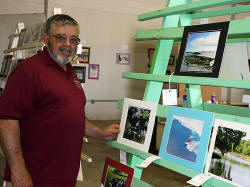|
 In the 1950s, Robert was helping a
farmer cut beans. One day his employer said, "You can help me cut
beans and I'll give you $4, or you can help me in the 4-H barn at
the fair and I'll buy your lunch." In the 1950s, Robert was helping a
farmer cut beans. One day his employer said, "You can help me cut
beans and I'll give you $4, or you can help me in the 4-H barn at
the fair and I'll buy your lunch."
A storm had wrecked the barn and the farmer and his peers were
repairing the damage, so Robert chose the 4-H barn.
"He started helping (with the fair) years back," Jo Ellen said.
"He helped with the 4-H chickens and rabbits. He's been with the
fair since 1963."
Jo Ellen began her affiliation in the early 1970s, when she
started the goat show.
"When I was a kid," she said, "I used to go to the photography
exhibit at the Illinois State Fair and I just loved it."

Consequently, when she and Robert had the chance to take over
Logan County's photography exhibit, they jumped at the opportunity.
"We used to have to hang all of the photographs on hooks," Jo
Ellen said. "Robert made racks for them to sit in."
"We built two a year for four years," her husband explained.
"They've all been a work of love."
The racks are stored at the fairgrounds, and workers help Robert
set them up before the show.
His wife finds judges, usually rotating between local
professional photographers for the closed judging session that takes
place on the first official day of the fair.
Jo Ellen said the 2011 photography exhibit would feature 462
pictures from 55 exhibitors. They come from all over Logan County,
as well as Bloomington, McLean, Altamont and Homer Glen.
"The entries are down from some years," she said. "We usually
have between 400 and 500 pictures on the wall. When digital cameras
came in, that really helped the show. Ordinary people can take great
pictures." One year, so many photos came in that Robert had to make
another display rack.
Jo Ellen noted that the number of entries usually rises and falls
on alternate years.
"If there are a lot of entries one year, the next year people
think, 'I don't have a chance,'" she said. That drives the number of
entries lower the following year. Then prospective contestants
think, "Well maybe I do have a chance," and entries increase again
the third year.
As people bring in their photos, Jo Ellen and Robert sort them
into categories, which continue to expand. One more recent addition
in the 21 classes was for pictures digitally manipulated on the
computer.
"We wanted to discourage people from manipulating all of their
entries on the computer," Jo Ellen explained.
They've also added a sports class. This year's new category is
"Echoes of Abraham Lincoln." The Lincoln class is for photos taken
at events celebrating the 200th anniversary of the 16th president's
birth. Jo Ellen said contest categories like that one tend to run
about a year behind the celebrations.
When the Maskes started helping with the photo contest, everyone
mounted their pictures in mats.
"Now, an 8-by-10 on a mounting board is OK too," Jo Ellen said.
"Double-sided tape doesn't work very well. Hot glue is the best, but
then you can't recycle your mats."
[to top of second column] |

Acknowledging that prints and mats can get expensive, she
commented, "People don't really enter the show to make money. And,
you can enter 21 pictures for $8."
She said the judges pick a Best of Show for both the black and
white and color photo divisions. Lincoln College sponsors the two
winners' plaques.
"We started giving five places (in each class)," she said, "but
there were so many entries we went to eight places, even though the
lower places only get $2."
Each class often has as many as 30 pictures.
Jo Ellen is firm about keeping all of the photos the same size,
to enhance the appearance of the exhibit. She urged prospective
contestants to read the fair book carefully and to follow the rules
when preparing their entries. All of the pictures must come from
amateur photographers.
"They don't do it for the money," Jo Ellen reiterated. "We do
have a kind of gray area for people who may take pictures at their
friend's wedding. But we consider them professional photographers if
they take money for their pictures, even if they don't make all of
their money at it."

Jo Ellen said a lot of the photos that come in are souvenirs from
vacation trips.
"The last few years, the pictures were vacation pictures from
different parts of the world, not just the country," she said.
"People have more opportunities to go further afield."
A memorable example was a photo a young man took of a whale
during a whale-watching expedition.
"I couldn't believe a kid took it," Jo Ellen said. "It was
gorgeous! You could see the whale's tail and everything."
She has no favorites among the different classes. "I just love 'em
all," she said. "I do like the color (photos). Black and white is
very nice and very artistic," but Jo Ellen thinks some categories
look better in black and white than others.
"I think it's harder to get a dramatic picture of a sunset or
water in black and white," she said. "I thought for a while, black
and white would just die out."
But again, digital photography that allowed prints to be made in
either color or black and white saved the day.
Next year, the Maskes plan to be at their post again, setting up
the stands and checking in the entries.
"The more the merrier," Jo Ellen said. "It's a good-caliber
show."
[By NANCY SAUL]
 |